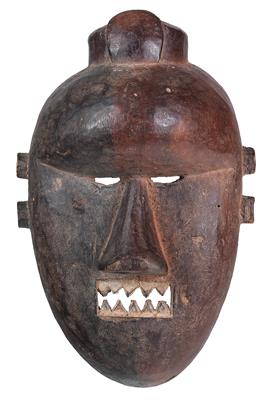Salampasu (also Basalampasu), Dem. Rep. of Congo: a warrior mask, called ‘Kasangu’, coloured black and reddish-brown.
Salampasu (also Basalampasu), Dem. Rep. of Congo: a warrior mask, called ‘Kasangu’, coloured black and reddish-brown.

The Salampasu in the south of the Congo had a male society called ‘Isuku’. This ‘Isuku society’ knew two types of masks for high-ranking members and warriors who had killed enemies in battle. One of the mask types is called ‘Kasangu’ and consists only of wood; the front side of the mask is dyed (as with the present piece). The second, very similar but more prestigious type is called ‘Mukinka’. Its front side, the face, is completely covered with detailed copper stripes.
The present ‘Kasangu mask’ conforms exactly to the style of the Salampasu. It is carved from hard, heavy wood. The right side of the face is black, while the left half is coloured in dark reddish-brown, like the upper surface of the crest, carved from the same piece, on the crown of the head. In conformity with the Salampasu style, the mask has a very bulging forehead, small, deep-set eyes above a wide, short, slightly curved nose. The almost rectangular, open mouth displays two rows of pointed teeth, which were originally dyed white. On both temples there are two decorative scarification marks, represented as round knobs.
The mask was tied to the head of the mask dancer by means of two larger holes (behind the decorative scarification marks). In the smaller holes around the circumference of the mask rim, a net of plant fibres was tied, that was pulled over the head of the dancer. A typical ‘Kasangu mask’ with original repairs to the left rim of the mask and to the tip of the nose (glued), an old, small loss to the lower left scar knob, and a thin crack to the upper mask rim on the back. Otherwise no damage. Good, partly shiny, partly encrusted patina, particularly on the inside, with shiny areas where the nose, cheeks and chin of the mask dancer often rubbed against it.
Height: 28 cm; width: 18.5 cm.
First half of the 20th century. (ME)
Provenance:
Austrian private collection.
Lit.:
‘Si vis pacem para artem. La création plastique chez les Salampasu’ by Julien Volper, ill. 13, p. 88, p. 80 to 92 et passim; ‘The Tribal Arts of Africa’ by Jean-Baptiste Bacquart, p. 181, ill. 6; ‘Die Kunst des schwarzen Afrika’ by Kerchache, Paudrat, Stephan, ill. 753.
Expert: Prof. Erwin Melchardt
 Prof. Erwin Melchardt
Prof. Erwin Melchardt
+43-1-515 60-465
erwin.melchardt@dorotheum.at
20.02.2017 - 14:00
- Vyvolávací cena:
-
EUR 1.000,-
Salampasu (also Basalampasu), Dem. Rep. of Congo: a warrior mask, called ‘Kasangu’, coloured black and reddish-brown.
The Salampasu in the south of the Congo had a male society called ‘Isuku’. This ‘Isuku society’ knew two types of masks for high-ranking members and warriors who had killed enemies in battle. One of the mask types is called ‘Kasangu’ and consists only of wood; the front side of the mask is dyed (as with the present piece). The second, very similar but more prestigious type is called ‘Mukinka’. Its front side, the face, is completely covered with detailed copper stripes.
The present ‘Kasangu mask’ conforms exactly to the style of the Salampasu. It is carved from hard, heavy wood. The right side of the face is black, while the left half is coloured in dark reddish-brown, like the upper surface of the crest, carved from the same piece, on the crown of the head. In conformity with the Salampasu style, the mask has a very bulging forehead, small, deep-set eyes above a wide, short, slightly curved nose. The almost rectangular, open mouth displays two rows of pointed teeth, which were originally dyed white. On both temples there are two decorative scarification marks, represented as round knobs.
The mask was tied to the head of the mask dancer by means of two larger holes (behind the decorative scarification marks). In the smaller holes around the circumference of the mask rim, a net of plant fibres was tied, that was pulled over the head of the dancer. A typical ‘Kasangu mask’ with original repairs to the left rim of the mask and to the tip of the nose (glued), an old, small loss to the lower left scar knob, and a thin crack to the upper mask rim on the back. Otherwise no damage. Good, partly shiny, partly encrusted patina, particularly on the inside, with shiny areas where the nose, cheeks and chin of the mask dancer often rubbed against it.
Height: 28 cm; width: 18.5 cm.
First half of the 20th century. (ME)
Provenance:
Austrian private collection.
Lit.:
‘Si vis pacem para artem. La création plastique chez les Salampasu’ by Julien Volper, ill. 13, p. 88, p. 80 to 92 et passim; ‘The Tribal Arts of Africa’ by Jean-Baptiste Bacquart, p. 181, ill. 6; ‘Die Kunst des schwarzen Afrika’ by Kerchache, Paudrat, Stephan, ill. 753.
Expert: Prof. Erwin Melchardt
 Prof. Erwin Melchardt
Prof. Erwin Melchardt
+43-1-515 60-465
erwin.melchardt@dorotheum.at
|
Horká linka kupujících
Po-Pá: 10.00 - 17.00
kundendienst@dorotheum.at +43 1 515 60 200 |
| Aukce: | Mimoevropské a domorodé umění |
| Typ aukce: | Salónní aukce |
| Datum: | 20.02.2017 - 14:00 |
| Místo konání aukce: | Wien | Palais Dorotheum |
| Prohlídka: | 11.02. - 20.02.2017 |
